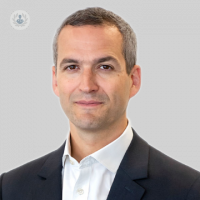Robotic hernia surgery: an in-depth analysis
Written in association with:We recently spoke to highly experienced, skilled, and well-regarded London-based consultant colorectal surgeon, Mr James Kinross, who, in our latest article here, provides us with an in-depth analysis of robotic hernia surgery, including the risks involved and its overall effectiveness.

What is the significance of robotic hernia surgery when comparing it to traditional surgeries?
The biggest impact that I’ve seen of robotic surgery is in incisional hernia repairs, which can be quite complicated. The more conventional way of repairing incisional hernias involves making quite a large incision. These more traditional surgeries take a long time, and recovery from these surgeries tends to be prolonged and can take many weeks to recover.
So, we have really seen robotic surgery’s effectiveness when it comes to repairing these complex hernias in patients’ abdominal walls. The recovery time is dramatically shortened when robotic hernia surgery is performed in these cases, patients tend to experience less pain afterwards, and of course the cosmetic effect is excellent.
What challenges for traditional surgery are different when considering robotic hernia surgery?
Incisional hernias can be extremely challenging as the anatomy is very variable and because the surgery is technically very demanding. When you have had a prior incisional hernia operation, the body forms scar tissue inside the abdominal cavity, which we refer to as adhesions.
These adhesions can sometimes be very dense and extremely difficult to dissect through without causing some form of injury to important organs like the bowel. So, robotic surgery allows us to take down those adhesions and can also reconstruct the muscles of the tummy wall very, very precisely indeed.
What are the risks involved in robotic hernia surgery?
We always warn patients that there is always some risks involved with robotic hernia surgery. The main ones include the following:
- bleeding
- wound infection
- hernia recurrence
- chronic pain in the wound
- mesh-related complications
What exactly is involved in a robotic hernia surgical procedure?
Patients will come to the operating room on the morning of surgery, where they will get a general anaesthetic. Occasionally, we need to give some patients a spinal anaesthetic as this will effectively numb the abdomen and it helps with the recovery.
The operation itself takes a variable amount of time. They can range from anywhere between an hour and a half to six hours. It really depends on the type and size of the hernia that we are operating on.
Usually, the patient will have two consultant surgeons operating: one will be close to and operating the robot and one will be at the bedside. There is also a specialist team in robotic surgery there with us to assist.
After the surgery, the patient will go to a designated recovery area where they will be monitored before being returned to the ward. Patients will occasionally need to go to high-dependency units for one night to recover, but most of the time, patients are up on their feet the following day.
It is also quite common to require drains that come out of the abdominal wall after surgery, which helps take any excess fluid away from the wound and reduces infection rates.
Mr James Kinross is a highly accomplished consultant colorectal surgeon who is nothing short of an expert when it comes to dealing with all types of hernias, as well as performing hernia surgery. Book an appointment with him today via his Top Doctors profile.


